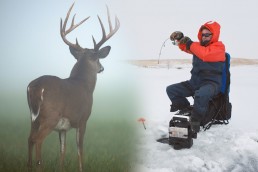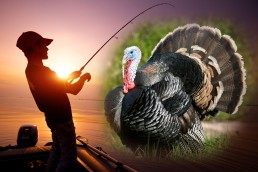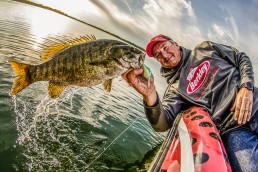Early Spring Illinois Bass Fishing
SHARE THIS POST
Many of us “northern” fishermen watch in frustration as our southern brethren are already fishing for bedding bass. As we escape winter, many of us are clueless as to what happens to fish during this transition period. Here are some suggestions to prepare for early spring bass fishing in Illinois, and to overcome the “slow” bass fishing associated with this time of year.
Preparing for your first fishing outing
One of the keys to being ready for spring open water is having your tackle ready. While you could wait until the ice is gone, ideally you’ll have everything ready to go so that you aren’t stuck organizing tackle during valuable fishing time.
During the winter, I like to stock up on new tackle, replace anything that is wearing out (and anything I don’t use), and lubricate and respool my reels. I recommend that in the fall you take the line off of all of your reels and store your gear indoors––the brutally cold winters we have had these past few years can take a toll on your fishing gear.
Early spring tactics
With early spring water temps going as low as 40 degrees, many people assume that you need to fish slow, but that is not necessarily the case. The Rat-L-Trap lure can be very effective when fishing 40- to 50-degree water temps, especially when you find grass. It is a very simple bait that even beginners can fish. When fishing it in the spring, cast it as far as you can, let it sink to the bottom, and reel it right over the grass.
Another good technique is to “yo-yo” your Rat-L-Trap off of the bottom. For this technique, let it sink to the bottom and then rip it up off of the bottom quickly, and then allow the lure to sink back to the bottom. This technique is super good at imitating dying shad which are prevalent during the spring.
Another lure to try is a ½-ounce Strike King Red Eye Shad, which has been effective in most of the ponds I have fished this spring. If I am fishing any deeper than 10 feet or trying to fish it really fast, I will move up to a ¾-ounce Rat-L-Trap. I like to throw Rat-L-Traps on a rod that has a soft tip but a stiff backbone. This allows you to be able to get a good hookset without ripping the treble hooks out of the fish’s mouth.
Are you enjoying this post?
You can be among the first to get the latest info on where to go, what to use and how to use it!
You will find a lot of early spring bass on areas where they have access to both deep water and spawning flats, so that they can pull up to spawn as soon as the water warms up. In smaller ponds I will often find them in 7 to 8 feet––because it is a smaller body of water, it takes less time for the water to heat up, so the fish in smaller ponds will generally spawn before the fish in bigger lakes do. When the water begins to warm past the mid-50s, I like to start throwing spinnerbaits and chatter baits, but the fishing is usually so good by then that you can throw almost any moving bait and catch fish.
Early spring tournaments
Early spring tournaments can be absolutely brutal. Much of them are accompanied by cold, rain, and an empty weigh-in bag. But if you know how to fish through it, you can do a lot better than you might think. Much of early spring is going down a rock bank and throwing crankbaits while you constantly cull out 12 inchers to weigh in your measly 8 pounds at the end of the day.
The key to winning early spring tournaments is locating the bigger fish. Early spring tournaments are tough for so many people because they don’t want to sit in 50 degrees and rain to get only 5 bites in 6 to 8 hours. Bigger fish tend to be lazier than smaller fish, which is why they are harder to catch.
To catch the bigger ones you need to fish much slower, picking apart pieces of cover and making up to a dozen casts at one stump before moving on. You don’t necessarily need to throw bigger baits, although it can be helpful in some situations. For example, when I’m unhooking treble hooks from 8 inchers cast after cast I will switch to a bigger bait so that I’m not wasting precious time unhooking fish that won’t help me win the tournament.
The ice fishing connection
Something to remember for next winter is that ice fishing will help you prepare for early spring. While many people may think that ice fishing is something you do on the side while waiting for open water, a lot of times it can help with your open water skills. Ice fishing is especially good at helping you locate fish. If you find fish ice fishing in, say, 10-12 feet, when the water opens up try the same general area but a couple feet shallower. It also helps you identify how the fish are feeding during the winter. Through the ice, they might want an aggressive jigging spoon or a small tungsten jig that barely moves. You can use this and translate it to your first early spring fishing outing.
MWO
SHARE THIS POST
Did you enjoy this post?
You can be among the first to get the latest info on where to go, what to use and how to use it!
Carter Wijangco
High schooler Carter Wijangco is a frequent winner of adult and high school tournaments, including the 2018 Bassmaster Junior National Championship in Tennessee. A suburban Chicagoan, Wijangco has been fishing locally for the past 10 years, and has been involved in tournament bass fishing for the past 5. He is working toward his Eagle Scout rank by building fish cribs for the forest preserve, and hopes to someday fish at the professional level.



